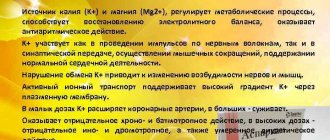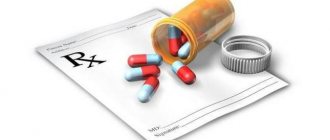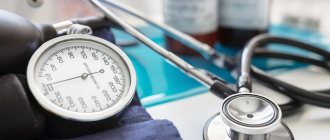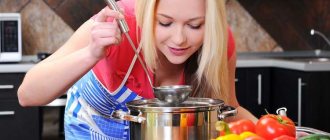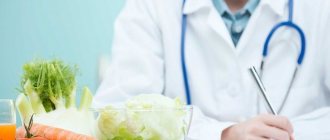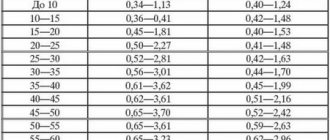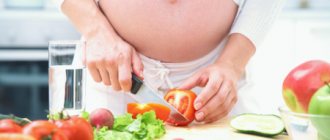17.08.2017
Last modified: August 2, 2021 at 11:27 pm
Hypertension is a disease that ranks first in Russia in terms of mortality. The scary words “stroke”, “heart attack”, “heart failure” are typical complications of high blood pressure.
One of the factors contributing to the development of hypertension is excess weight. A patient with hypertension falls into a trap: he loses weight like an ordinary healthy person. Serious physical activity can cause a hypertensive crisis, strict diets are contraindicated... What to do?
Basic rules of nutrition for hypertension
Vitamin complexes will help saturate the body with useful minerals, and limiting salt will prevent the accumulation of excess fluid. A well-thought-out menu and adherence to diet rules help normalize blood pressure.
To combat hypertension, a comprehensive approach is required, including:
Rejection of bad habits. Weight loss. Compliance with work and rest schedules . Diet food. Favorable psycho-emotional background.
Among all the factors, proper nutrition is considered one of the main ones.
To create a diet, you should use the following recommendations:
Reduce salt intake to 5 g per day. Limit the consumption of easily digestible carbohydrates (jam, sugar, honey). To maintain water balance, it is enough to consume 1.2-1.5 liters per day (drinking too much causes swelling). Include butter Potatoes , legumes, dark breads should be consumed in limited quantities. The main part of the diet should be fresh vegetables/fruits and cereals. Meat is allowed to use chicken breast , rabbit, and turkey fillet. Heat treatment is carried out mainly by boiling or steaming; it is allowed to bake dishes in the oven.
Diet for weight loss for hypertension
The diet for hypertensive patients is characterized by the consumption of easily digestible foods, which has a common context with the diet table for weight loss. Therefore, there are types of diets with double action. If you follow a certain diet, you will not only feel better, but also lose weight.
The products used are low-calorie, and a balanced table helps stimulate the digestion process. Eating a large amount of vegetables is accompanied by cleansing the intestines of toxic substances and breakdown products that poison the microflora.
The formation of a healthy environment improves metabolic functions at the cellular level. Reducing salt consumption or avoiding it has the effect of freeing the body from excess fluid, which affects weight. The vitamin complex restores vital systems.
After regulation of metabolic processes, accelerated breakdown of fat occurs. A poor diet stimulates the body to look for missing calories in fat layers.
The most famous dual-action diet is DASH, developed by American nutritionists and doctors. It includes all the necessary rules for controlling blood circulation and losing weight. It was called the most popular and effective.
Some patients managed to overcome hypertension and acquire beautiful body shapes. Among other things, the diet reduces the risk of stroke, removes kidney stones, prevents the formation of certain types of malignant tumors, and has a beneficial effect on the body as a whole.
Basic Rules:

Distribute the daily diet into 5-6 small portions. Eat food according to the schedule. 2 hours before bedtime, stop eating any food. Maintain the ratio of the main groups of nutrients. The daily intake should contain: proteins 90 g (of which 50 g are of animal origin); carbohydrates 350-400 g (preference is given to vegetables, berries, fruits); fats 80 g (of which 25 g are of vegetable origin); When creating a menu, include a large amount of vegetables and fruits rich in magnesium, potassium and vegetable oils. low-fat dairy products daily Prohibited foods should be completely excluded from the menu. your water balance during the day with rosehip decoction, non-carbonated mineral water, and freshly squeezed juices from fruits and vegetables. prepare food other than frying. The food served should not be too cold or hot. Limit or completely eliminate the addition of salt. It is effective to supplement the dietary table with a complex of vitamins with the necessary group of minerals (A, B, C, E, potassium, magnesium, iodine, phosphorus, calcium).
The importance of gender in dieting
When creating a menu to reduce blood pressure, gender matters. Food for men with hypertension should not only be healthy, but also high in calories. With the right approach, the menu for hypertensive patients will be quite nutritious and satisfying. For example, to prepare meat dishes, you can use not a frying pan, but a grill that does not require adding oil.
Women have a lower natural need for high-calorie foods. Therefore, their diet may include more dietary dishes. Cooking with olive oil and maintaining a balance of fats and vitamins will help you get your figure and well-being in order. Women need to include foods with omega-3 in their diet.
Important! Weight loss with a diet for hypertensive patients should proceed smoothly.
List of permitted and prohibited products
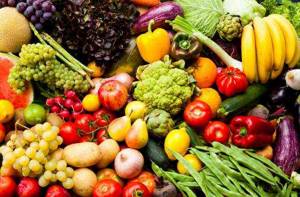
Authorized products:
cottage cheese (up to 5% fat); eggs (no more than one per day, soft-boiled); garlic in any form; lemons, grapefruits; fresh vegetables, herbs, fruits; compotes of berries, dried fruits, freshly squeezed juices, rosehip decoctions; jelly, jelly; milk and low-fat dairy products; cereals; dried fruits; lean meat and fish; homemade vegetable and fruit sauces;
Prohibited products:
fish and meat of fatty varieties; nuts; concentrated broths; mushrooms; legumes; pickles and marinades; smoked meats; drinks containing dyes, preservatives, gas, alcohol; pickled vegetables; sausages; fast foods and semi-finished products; coffee, cocoa, strong teas;
In addition, you should significantly reduce your salt intake or stop using it. Various seasonings and spices usually have a combined composition of herbs and seeds, many of which have an effect on blood circulation. Therefore, during a diet and in everyday life, it is better to abandon their use or reduce their use to a minimum.
Product selection
To properly lose weight with hypertension, you not only need to reduce calories, but also choose the right foods:
- Add vegetables and greens to every meal, especially garlic and onions, spinach and celery (they help lower blood pressure). You can eat potatoes in limited quantities, and it is recommended to bake them in their skins.
- In between main meals, eat fruits and berries, with priority given to those that are sources of potassium. These are: black currants, red grapes, peaches, apricots, pineapple, apple, small bananas.
- Eat nuts and dried fruits, especially walnuts, almonds, dried apricots and prunes, as such foods strengthen the heart. It is recommended to eat a handful of nuts or dried fruits per day. You can pre-fill with natural yoghurt.
- Limit the amount of fat in your diet. So, you will need to give up butter, fatty meats and fish, smoked meats, semi-finished products and fermented milk products with high fat content. They need to be replaced with healthy fats, which are found in vegetable oils, nuts, and low-fat fermented milk products.
- Relegate meat dishes to the background, and cook them from lean meats that are easily processed and do not put a strain on the heart. So, you should choose lean meat, with chicken fillet being a priority.
The DASH diet involves gradually giving up meat and switching to a vegetarian diet. However, if a hypertensive patient cannot imagine his diet without meat, he does not need to forcibly give up his favorite dishes, but rather eat lean meat, not by frying, but by baking, boiling or steaming.
- Place great emphasis on fish and seafood, as they are valuable sources of fatty acids. It is advisable to have one dish of these products on the table every day. For example, you can cook fish soup, steamed fish cutlets, baked fillet or rice with seafood.
- Include grains, grains and beans in your daily menu. They can be prepared with either water or low-fat milk.
- Completely avoid: salty foods, especially chips, snacks, crackers, marinades and pickles; sausages and sausages; Sahara; yeast bread and baked goods containing stabilizers and cooking oil, including baguettes, puff pastries, buns.
- Use stevia or honey as a sweetener. Lemon and honey will especially help with hypertension.
- From drinks, completely exclude soda, coffee and strong tea, and alcohol is allowed only on holidays in the amount of one glass per evening. The priority is herbal teas, which have a good effect on both the stomach and the nervous system. In addition, you can afford green or black tea of weak strength. As for fermented milk products, you can drink kefir, fermented baked milk, yogurt and low-fat milk.
If hypertension is stage 2 or 3, the weight loss diet is more strict, so the list of prohibited foods expands. So, you will have to give up:
- fruits with coarse fiber;
- Luke;
- garlic;
- radish;
- sorrel;
- mushrooms;
- beans;
- caviar.
In the next video, Elena Malysheva will talk in detail about the DASH diet and clearly show the daily diet for high blood pressure, paying special attention to prohibited foods:
Sample menu for the week
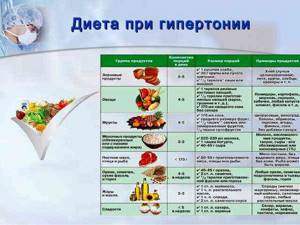
The daily diet is divided into 5 meals.
1 day:
omelette with onion and tomato, herbal tea; oven-baked apple; vegetable puree soup, steamed chicken cutlets, rice, dried fruit compote; yogurt; steamed fish meatballs, vegetable salad, tea with milk;
Day 2:
soft-boiled egg, tea. freshly squeezed spinach and carrot juice; hake fish soup, buckwheat porridge, sliced vegetables, jelly; cottage cheese casserole; boiled chicken breast, tea with milk;
Day 3:
oatmeal, tea; fruit jelly, dried fruits; soup with rabbit meatballs, vegetable salad, dried fruit compote; kefir; fish with vegetables baked in the oven;
Day 4:
cottage cheese casserole, milk; fruit jelly; vegetable stew, boiled chicken breast, tea; kefir; steamed rabbit cutlets, mixed vegetables;
Day 5:
omelette, tea; vegetable cocktail; vegetable puree soup, rabbit in cranberry sauce, jelly; yogurt; steamed fish cutlets, mixed vegetables, tea with milk;
Day 6:
oatmeal, herbal tea; fruit cocktail; fish soup, buckwheat, vegetable salad, compote; cottage cheese; chicken breast with vegetables, cooked in the oven, tea;
Day 7:
cottage cheese casserole, milk; vegetable smoothie; vegetable stew, steamed fish, jelly; fruit jelly; rabbit cutlets cooked in the oven, vegetable mix, tea;
Recipes
Fish with vegetables
Wash the pollock fillet and lightly salt it. Grate the carrots on a coarse grater, and cut the onions into small cubes or half rings. Saute vegetables in vegetable oil for 3 minutes. Place a bed of vegetables on a baking sheet and cover with fish fillets on top.
Next, lay thin tomato rings and finish the layers with grated hard cheese. Bake in the oven for 15-20 minutes. Temperature regime – 180 °C. When serving, sprinkle with herbs.
Drink of vigor
Pour boiled cooled water into a jug. Add the juice of 1 lemon, a few mint leaves, a little chopped ginger and dried apricots. Leave for 2 hours at room temperature. Drink 150 g between meals.
Homemade sweets
Grind the dried fruits in a blender, add the crushed biscuits and mix thoroughly. Form small balls and place in the refrigerator for 4 hours.
Meat with vegetables
Cut the chicken fillet into thin layers. Add a little salt. Cut tomatoes, onions, and herbs into small cubes. Mix the vegetables. Place meat and vegetables on a baking sheet, sprinkle grated hard cheese on top. Bake in the oven for 35 minutes, keeping the temperature at 180°C.
Healthy recipes
When cooking, hypertensive patients must take into account that food must contain the optimal ratio of proteins, fats, carbohydrates, vitamins and minerals. This is an important rule for both losing weight and maintaining a healthy state. So, you should take into account recipes that comply with this rule.
Fish soup
Prepare in this order:
- Boil 2 liters of water in a saucepan and add 2-3 pre-chopped vegetables. potatoes and one onion, as well as grated carrots. Then add 100-150 g of washed rice.
- Cook the ingredients for 20 minutes.
- Using a fork, mash a can of canned saury or mackerel in its own juice and add to the soup.
- Mix and cook for 10 minutes, add bay leaf and pour in 2 tbsp. l. vegetable oil.
- 2-3 minutes before turning off the heat, add chopped herbs, such as dill and parsley.
This soup will allow you to get omega-3 fatty acids from sea fish, as well as potassium and magnesium from vegetables.

Lenten borscht
Preparing borscht without meat:
- Rinse 200 g of peas, add cold water and leave for 4-6 hours, drain the liquid.
- Peel 200 g of carrots and beets, grate or cut into strips.
- Cut the onion head into thin half rings, chop 200 g of white cabbage and pass 3-4 cloves of garlic through a press or finely chop.
- Boil 2 liters of water in a saucepan, add beets and carrots. Cook over low heat until half cooked, add onion and cabbage.
- Cook the vegetables until cooked, and 2-3 minutes before readiness add garlic and herbs to taste.
Fish cutlets
This recipe involves the use of sea fish - hake, cod or pollock back. The cutlets are prepared in this order:
- Wash and peel 1 kg of fish, separate the fillets from the bones and skin, pass through a meat grinder with 2 onions and 150 g of squeezed white bread. Pepper the resulting minced meat, add a pinch of sugar and mix.
- Form cutlets, roll in 2 tbsp. l. flour and fry in vegetable oil until golden brown.
- Prepare fish broth from the bones and skin, strain and pour over the prepared cutlets, previously placed on a baking sheet. Then put in the oven for 20 minutes.
Ready cutlets can be served with sour cream, herbs and vegetables.
Pilaf with meat
Pilaf is prepared with any lean meat:
- Wash and boil 125 g of meat. At the same time, boil 50 g of rice and place in a colander.
- Finely chop a quarter of an onion and 1 tomato. Fry in vegetable oil until done.
- Cut the meat into pieces, combine with rice and add vegetables. Mix and place on low heat or in the microwave for a few minutes until fully cooked.
When serving, the dish can be decorated with herbs.
Refusal of salt
Excess fluid is considered one of the causes of increased blood pressure. Consuming salt causes water retention in the body, so it is important to significantly reduce its use in cooking. The average daily value for a healthy person is 15 g.
When following a diet for hypertensive patients, it is worth reducing the norm to 5 g or completely abandoning the salt supplement.
When creating a menu, you should take into account that finished products already contain salt, so you need to reduce the recommended amount.
Expert opinions on complete abstinence from food are mixed. There is a high risk of attacks of weakness, dizziness and other negative manifestations. In addition, muscle tissue weakens, the appearance of which after weight loss is flabby and unsightly.
During the period of fasting, toxic substances are activated that are harmful to health.
Therefore, it is worth weighing the expected result and the threats.
If it is recommended to use
starvation
, then most often they use a one-day refusal of food with the obligatory consumption of water and vitamins. Longer treatment with hunger is prescribed by a doctor and carried out under his supervision.
How to lose weight for hypertensive patients
The scheme for any weight loss is simple. The body must burn more calories than it consumes.
Don't believe the advertisements for instant weight loss! No person will lose weight if they don't put effort into it.
Only a set of measures will give a positive result. This includes proper nutrition, an active lifestyle, and giving up bad habits.
If you have hypertension and high blood pressure, you should not follow diets. For such people there are their own therapeutic dietary programs. Only a doctor can prescribe and adjust special diets for weight loss.
You can't strive for quick results. You need to lose weight gradually and correctly. The diet should contain at least 1200 kcal, which is necessary for human life.
Rapid weight loss with hypertension is fraught with poor health and malaise. You need to lose weight over months and years.
Tips for losing weight:
- 5 minutes before meals you need to drink a glass of water. This will satisfy your hunger and prevent you from eating too much food. You can drink high-quality mineral water.
- You need to chew your food thoroughly, the longer, the better for the stomach.
- Try to eat no more than 20 minutes.
- Place food on a small plate, preferably blue. Scientists have proven that this color reduces the feeling of hunger, and small dishes make the amount of food abundant.
- You should not eat while reading a book or in front of the TV screen.
- Try not to add enough salt to your food. Salt increases blood pressure and leads to obesity.
- Try to eat a hearty meal at lunchtime so that you can unload your stomach with a light dinner in the evening.
- Make it a rule that after 7 pm you can only drink, excluding any snacks.
The food menu should not contain salty or spicy foods. During periods of fasting, you should not drink alcohol.
It is important to understand that the greater a person’s body weight, the higher blood pressure rises. His racing is dangerous for stroke and heart attack! Obesity with hypertension often leads to disability.
Author of the article Svetlana Anatolyevna Ivanova, general practitioner
How to lose weight with hypertension - Diet for weight loss with hypertension.
Efficiency

Following a diet and a comfortable rhythm of life will replenish the body with useful minerals and create conditions for the restoration of metabolic processes.
If you adhere to the specified diet for a month, you can achieve the following effects:
Cleanse the intestines of toxins and waste. Remove excess liquid. Stabilize blood pressure. Improve the functioning of the digestive system. Restore metabolic functions. Reduce weight from 4 to 12 kg.
Low-calorie food will help rebuild the body to a new regime, thereby changing the quality of life. A doctor-approved set of exercises will give you the opportunity to feel a surge of strength and energy.
Half of hypertensive patients, according to medical experts, are not even aware of their high blood pressure. The patient's blood pressure is over 150, but he does not feel it. Until a heart attack comes...
At the first stage of the disease, hypertensive patients do not often come for a consultation with a doctor, but arterial hypertension is the main cause of serious complications that lead to stroke, hypertensive crisis, myocardial infarction, renal failure, and heart pathologies. Hypertension is usually accompanied by a disorder of cholesterol metabolism in combination with atherosclerosis.
These indicators (both cholesterol and blood pressure changes) can be corrected with a balanced diet. Only this will not be a one-time experimental diet, but in fact a new way of life.
Why is this happening
Main causes of obesity:
- Overeating;
- Poor nutrition (snacks);
- Inactive lifestyle and sedentary profession.
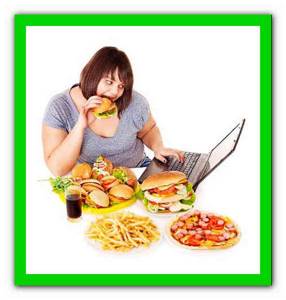
Later, during the student period, young people eat even worse, not following the correct regime during the day. Many people abuse snacks like pies, hamburgers, instant noodles, washing down such food with cold soda.
All this leads to disruption of metabolic processes in the body, which in turn leads to obesity and increased blood pressure. In addition to arterial hypertension, excess weight can lead to the development of atherosclerosis, diabetes, heart and kidney diseases, and stomach ulcers.
Principles of rational nutrition
The choice of dietary products for hypertension should take into account the degree of its severity and concomitant diseases. The energy value of the diet is ideally adequate to a person’s energy expenditure, with certain adjustments for atherosclerosis and high body mass index.
These conditions indicate that a therapeutic diet for weight loss for hypertensive patients should be selected together with a nutritionist or your therapist, endocrinologist. But the basic principles of its compilation are universal, they can be adhered to from today.
Here are 10 basic rules of healthy eating for patients with hypertension:
Limiting salt. This rule is dictated by serious processes occurring in the adrenal glands. They accumulate fluid and provoke an increase in blood pressure. Reducing salty foods in the diet will reduce excitability processes in the central nervous system (CNS). The salt norm for patients with hypertension is 4-6g/day (about 1 teaspoon, including salt in ready-made products). You should refrain from foods with a high salt content (herring, canned food, pickles). There is no need to reduce the amount of fluid if there are no problems with the circulatory system. You need to drink at least 2 liters of clean water per day. The amount of fat should be reduced to 75 g/day . Butter, lard, and other animal fats can sometimes be replaced with vegetable analogues - oil from sunflower, olives, corn, soybeans. They contain many polyunsaturated fatty acids that strengthen the immune system. The proportion of protein in the total mass of food products does not need to be reduced : the daily norm is determined at the rate of 1.5 g/1 kg of weight. A deficiency of this valuable building material for cells reduces the body's endurance under stress.
The exception is patients with complications in the form of nephroangiosclerosis, which retains nitrogen compounds in the body. In this case, the percentage of protein products is reduced.
Carbohydrates are not limited, their types are changed. Easily digestible, so-called “fast” carbohydrates (sweets, baked goods, honey) should be kept to a minimum. They are replaced with products of plant origin with a high concentration of fiber. There should be as much fiber as possible in the form of grains (slow carbohydrates). It helps remove cholesterol and improves intestinal motility. In case of obesity, such a reduction in calories does not leave a feeling of hunger. Reduce high-fat dairy products with a coagulating effect (vasoconstriction, blood clotting). Limit biogenic amines; there are many of them in herring, hard cheese, tomatoes, and legumes. Control foods that stimulate the heart and central nervous system (concentrated broths and sauces, strong drinks - tea, coffee, alcohol), which have an aggressive effect on the kidneys (spicy, smoked foods and spices). Add foods that contain lipotropic compounds , especially for atherosclerosis: veal, chicken eggs, lean fish and cheese. They restore metabolic processes.
There are many lipotropic compounds in foods high in protein.
A prerequisite is regular intake of vitamins and minerals that control all vital functions: Niacin, which dilates blood vessels, improves blood flow in the kidneys, brain, coronary blood supply; Ascorbic acid, which accelerates recovery processes and lowers cholesterol; Riboflavin, which is involved in the normalization of tissue respiration and the production of ATP, which controls metabolic processes; Pyridoxine, which helps neutralize cholesterol; Bioflavonoids, which strengthen blood vessels and prevent the penetration of cholesterol; Potassium, which enhances the contractile ability of the myocardium in case of circulatory disorders (there is a lot of this mineral in cocoa, beef, and products of plant origin); Magnesium, which accelerates inhibition in the cerebral cortex, reduces vascular spasms that provoke an increase in blood pressure
People get magnesium from legumes, grapes, apricots,
rosehip
, some cereals.
; Iodine, which has an anti-sclerotic effect (there is a lot of it in seafood).
The most important condition for a rational diet for high blood pressure is split meals. You need to eat 4-6 times a day, have dinner 3 hours before bedtime.
Poor nutrition
Obesity with hypertension does not just happen! This is caused by eating disorders and abuse of high-calorie foods.
Poor nutrition, which leads to high blood pressure:
- 3 meals a day. This regime has long been recognized throughout the world as erroneous. It is more correct to eat 5-6 times a day, in small portions.
- In the evening, in front of the TV, many people have frequent snacks. And many people generally gorge themselves at night, forcing the body to store fat. It’s not for nothing that nutritionists around the world say that you shouldn’t eat after 6 pm.
- It is impossible to convey floury, fatty, salty. It is better to replace these foods with vegetables and fruits.
- You should not eat a lot of sweet or salty foods. Everything should be normal.
- Frequent snacking between main meals leads to weight gain.
- You can't eat a lot of fried food. It is better to boil or stew.
Scientists: “The greater a person’s body weight, the shorter his life.”
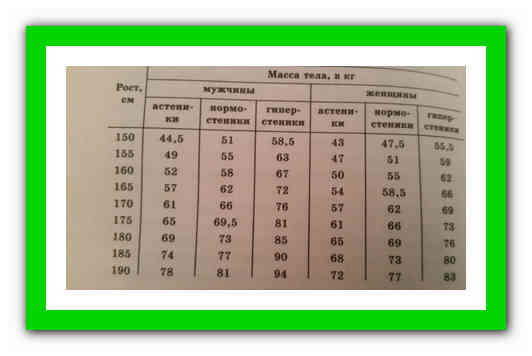
Table for determining normal body weight
Well, did you compare your weight according to the table? If your body weight is at least 10% higher than normal, then you are on the right path to obesity! Review your diet and daily routine.
If your kilograms exceed the norm by 30%, you have stage 1 obesity. Contact your doctor for help.
If from 30 to 50%, then the second one. If the percentage is between 50 and 100%, this is the third degree of obesity. Over 100% is the fourth stage of the disease.
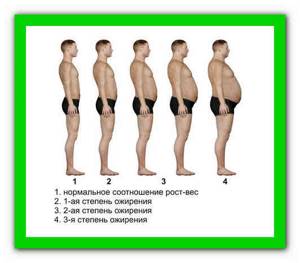
Types of therapeutic diets
You can get an idea of the basics of nutrition for hypertensive patients from diet No. 10, which is relevant primarily for poor blood flow.
Diet for hypertension: choosing the best option
from numerous proposals.
Read here how folk sbiten helps defeat hypertension.
Diet No. 10 for hypertensive patients for weight loss: daily menu
Cheese (120 g), semolina porridge (150 g), tea (1 glass); Apples (100 g), low-fat kefir (1 glass); Barley soup (250 g), meat, carrots (55/150 g), compote (1 glass); Rosehip drink (1 glass), 1 piece of whole grain bread; Fish, potatoes, steamed (85/150 g), pilaf with dried fruits (100 g), tea (1 glass); Kefir (1 glass) - before bed.
The daily norm of bread is 250 g, sugar – 50 g. If your weight is higher than normal, in addition to diet, fasting days (with salads, rice, watermelons, apples) will be useful.
DASH Diet
The acronym DASH simply stands for: Dietary Approach to the Treatment of Hypertension. The principles of this type of nutrition were developed by Harvard scientists. Today it is the most popular diet in Europe. The authors claim that the products offered in the diet lower blood pressure and the likelihood of developing a stroke, remove kidney stones, and prevent the formation of malignant tumors. You can get an idea of DASH from the sample menu:
Fresh orange (1 cup), flakes (from corn, oats, barley) - (2 cups), margarine (1 tsp), low-fat milk (1 cup); 2 slices of bread, low-fat ham (70 g), a piece of cheese, lettuce (2 leaves), tomato (half), mustard (1 tsp), apple; Chicken with rice, buckwheat or pearl barley porridge, peas (½ cup), small whole grain bun, low-fat milk (1 cup); Dried apricots, nuts (50 g each), 1 grapefruit - for snacks.
It is recommended to introduce the diet gradually, without stopping the prescribed medications that lower blood pressure. A feature of the American diet is a small proportion of meat in the diet.
The main emphasis is on products enriched with vitamins and microelements. Meals are fractional. Salt consumption should be gradually reduced to a minimum. For hypertension, this diet is recommended as the main diet.
Potassium diet
Potassium for arterial hypertension is often prescribed additionally or a special diet is recommended. Such a selection of products relieves swelling, lowers blood pressure, and improves blood flow. Its features: low calorie content, reduced sodium, lack of extractive ingredients, saturation of organs with potassium in a ratio of 8:1 - 14:1 (relative to sodium). You can evaluate its capabilities using the example of a one-day menu:
Potatoes (200 g), coffee, milk (1 cup), rice water (1 cup); Fresh cabbage (100 g); Potato and cabbage soup and puree (200 g each), jelly; Rose hip drink (100 g); Mashed potatoes (300 g), rosehip infusion (100 g).
Bread without salt – 250 g, sugar – 30 g. Heat treatment of food raw materials: boiling, cooking in a double boiler or in the oven. All dishes for hypertensive patients are prepared without salt; they are slightly salted when ready-made, before eating.
The lighter diet is complemented by foods enriched with potassium: dried fruits, fresh and baked apples, rosehip infusion, potatoes, cabbage.
Magnesium diet
Magnesium regulates the functioning of the central nervous system, strengthens the heart muscle, and neutralizes vascular hypertonicity, which is very important for high blood pressure, especially with complications such as atherosclerosis. Therefore, hypertensive patients are prescribed medications with magnesium that lower blood pressure and cholesterol levels, or a three-day diet composed of appropriate foods.
Its peculiarity is its low calorie content, salt and liquid restrictions, and enrichment with potassium and magnesium. Meals are six times a day. The bread norm is 125 g/day. An idea of this type of diet can be obtained from an approximate one-day menu.
Buckwheat porridge with bran (150 g), tea (1 glass), lemon slice; Apricot juice (100 g); Borscht with bran broth (250 g), pilaf with dried apricots and rice, blackcurrant compote; Rosehip infusion (100 g); Carrot and apple cutlets (200 g); Warmed milk (100 g).
With a magnesium diet for hypertensive patients when losing weight, the main attention is paid to products that contain this mineral: buckwheat, oats, millet, nuts, greens, legumes.
Fruit and vegetable diet
This type of nutritional therapy is prescribed for vascular atherosclerosis, symptomatic hypertension, and excess weight. The diet reduces the excitability of the central nervous system, improves kidney function, and normalizes weight and blood pressure.
In terms of energy value, a hyposodium vegetarian diet can be considered optimal. Restrictions apply to refined carbohydrates, salty foods, liquids and extractive ingredients that aggressively affect the gastrointestinal tract and other vital centers.
The table is rich in vitamins and fiber, which breaks down fats. Vegetables and fruits are used to prepare juices, soups, salads, compotes, purees, and vinaigrettes. Meals are five times a day, with snacks. An example table on a vegetarian diet might look like this:
Warmed infusion of rose hips or dried currants (1 glass), apple and carrot salad with butter; Fruit juice (½ cup), pureed vegetables; Vegetarian soup with croutons (250 ml), vegetable salad with sour cream; Nuts (100 g), salad of grated vegetables (carrots, beets, zucchini, cucumbers - 150 g); A heated infusion of rose hips or dried currants (1 glass) can be sweetened with 20 g of sugar or honey; Vinaigrette with butter (200 g), dried fruit compote (1 glass); Before bed – juice (1 glass).
Meal distribution
The required 2000 calories per day for energy expenditure became the basis for deciding how to lose weight if hypertension haunts you. Frequent consumption of food is recommended, at least 4-5 times a day
. The calorie content of the daily diet must be distributed approximately as follows:
- breakfast before work - about 30% of the daily calorie intake;
- 20% of the daily calorie intake is allocated for second breakfast;
- for lunch approximately 40% of calories;
- 10% is left for dinner.
It must be remembered that a diet for hypertensive patients to lose weight and restore blood pressure has the main rule: there should be a gap of at least 2-3 hours between dinner and bedtime
.
Particularly important in this diet is strict intake by the hour.
, which may cause slight difficulties in compliance:
- 7:45 – 20 drops of garlic tincture in vodka, wash down with 0.5 tbsp. rowan infusion;
- 8:00 – 1 tbsp. rosehip decoction;
- 10:00 – 1 tbsp. hawthorn decoction;
- 11:45 – 20 drops of garlic tincture in vodka, wash down with 0.3 tbsp. beet juice;
- 12:00 – no more than 0.5 liters of vegetarian, unsalted cabbage soup;
- 14:00 – 1 tbsp. rosehip decoction with the addition of 20 drops of garlic tincture with vodka;
- 16:00 – 1 tbsp. carrot juice with the addition of 1 tsp. garlic juice;
- 18:00 – no more than 0.5 liters of vegetarian, unsalted cabbage soup;
- 20:00 – 0.5 tbsp. carrot juice with the addition of 1 tsp. garlic juice;
- 22:00 – 0.5 tbsp. compote of raisins, figs and dried apricots with the addition of 20 drops of garlic tincture with vodka.
How it works
When adjusting your diet, in addition to your doctor’s advice, use the following general recommendations:
Control the salt level – up to 5 g/day; Reduce the proportion of quickly digestible carbohydrates; Add fatty dairy products to your diet in small portions; Limit the amount of black bread, legumes, potatoes; Not all meat is suitable - only rabbit, chicken, turkey fillet; Heat treatment eliminates frying; The main emphasis on the menu is fresh cereals and vegetables; Monitor your water balance (1.5-2 l/day).
The menu for hypertensive patients consists of easily digestible dishes, similar to a diet for losing weight, so it has a double effect: it corrects weight and blood pressure. Low-calorie meals and a balanced diet stimulate digestion.
A high percentage of vegetables in the diet improves intestinal motility, cleansing the body of waste, poisons, toxins and other breakdown products that poison its microflora. A healthy environment improves metabolism.
Excess weight goes away after getting rid of excess fluid that was retained by excess salt. Strengthens the functioning of all organs and systems and the vitamin complex.
If all metabolic processes are restored, increased breakdown of fat occurs, because a light diet will stimulate the body to extract the missing energy from fat deposits.
Comprehensive measures
The fight against high blood pressure involves comprehensive measures:
Weight loss; Control of bad habits; Friendly atmosphere in the family; Compliance with the work and rest regime; Proper nutrition.
Anyone who is at risk for high blood pressure should first of all reconsider their lifestyle, including eating habits, because lifestyle affects the quality of blood supply. When creating a diet, you need to have a good balance of proteins, fats and carbohydrates.
Vitamin supplements improve metabolic processes, and a salt-free diet will free the body of excess fluid. A thoughtful menu, selected taking into account the listed rules, will help normalize blood pressure.
The question of how to lose weight with hypertension without aggravating the course of the disease, first of all, is important to discuss with a cardiologist and nutritionist. For those suffering from high blood pressure and at the same time being overweight, this is a vicious cycle problem. After all, it is obese people who are at high risk of hypertension, and losing weight with such a disease is not only difficult, but may even be life-threatening. To get the maximum effect without harming your already poor health, you should choose the right diet and carefully plan your exercise program.
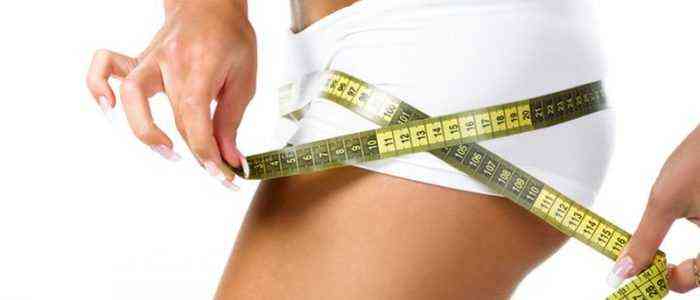
How to lose weight with high blood pressure

Weight loss for hypertensive patients should be within reasonable limits, taking into account the severity of the disease. Be sure to avoid excessive zeal, which can be extremely dangerous for the body.
Experts recommend paying attention to general recommendations for losing weight with high blood pressure without compromising your health:
- If your body mass index is more than 30 (indicates obesity), and in addition to hypertension there are heart diseases, then you need to lose weight at a slow pace. Heart patients should reduce weight by 200-300 grams per week.
- To speed up harmless weight loss, you need to reconsider your lifestyle so that the body receives fewer calories than it spends.
- A safe rate of weight loss is within 200-900 grams every 7-10 days.
- After losing weight, it is important to maintain the achieved result and keep the required numbers on the scale for a long time. A repeated jump in weight can worsen the well-being of a hypertensive patient.
- If a person’s weight is normal, you should try not to increase it.
The optimal option for losing weight is to reduce the calorie content of food consumed in combination with gradually increasing physical activity.
For example, to lose 450 g in one or two weeks, you need to reduce your daily caloric intake by 500 kcal. (without losing essential nutrients) or burn 500 kcal more than usual during exercise.
How to determine your normal weight
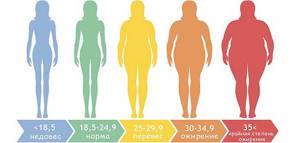
Before starting to lose weight, a hypertensive person must calculate his weight loss limit so as not to cross the line after which unreasonable disposal of obesity can lead to other pathological situations.
You can calculate the optimal body mass index (BMI) using the so-called “slimness formula.” This value is set as follows: body weight (in kilograms) divided by height (in meters) squared
As an example:
- Data. The patient's weight is 80 kg, height is 1.64 m.
- We make calculations. 80: (1.64 × 1.64) = 29.7.
- Result. BMI – 29.7 kg/m2.
What the result means is determined using a special table. As you can see, a person is obese, so correction of body weight is necessary. Ideally, the weight should “fall” by 25-30 kg.
| Calculation results | BMI value |
| Under 18.5 | Weight deficiency. |
| 18,5-24,9 | Normal weight. |
| 25,0-29,9 | Overweight. |
| 30.0 and more | Obesity. |
Significant importance when calculating BMI is given to waist size. Significant fat deposits in a given area of the body can distort the actual amount of excess weight. The following waist parameters are considered deviations from the norm:
- For women - more than 89 cm.
- For men – more than 101 cm.
Optimal rate of weight loss
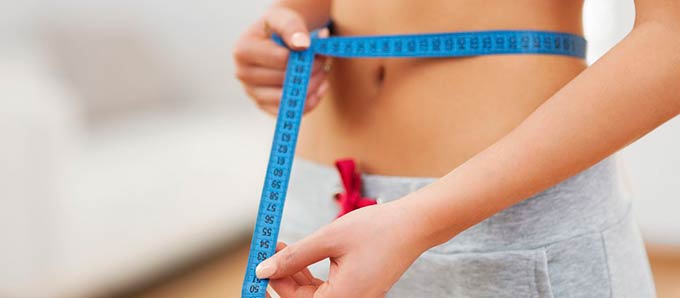
Excess weight can negatively affect the human body, but you can’t quickly get rid of unnecessary pounds either. If you rapidly reduce body weight, it will do more harm to your health than good.
So, how to properly and safely combat obesity? Experts have established a safe weight loss period for the body:
- One week is absolutely not enough for significant weight loss.
- With proper diet and regular physical exercise, a person loses up to 1 kg of unnecessary weight within a week. However, during this period, water will also be removed from the body, and not just fat deposits.
- In the subsequent period of weight loss, body weight should decrease by no more than 0.5 kg in 7 days, per month - no more than 2-5 kg.
- You need to start by reducing 10% of your existing weight - this is the starting point for all hypertensive patients.
What should your blood pressure be after losing weight? Doctors note that every kilogram lost on average lowers blood pressure:
- Upper – by 1.6 units.
- Lower – by 1.3 units.
Modern medicine adheres to the point of view that a harmless reduction in excess body weight for hypertensive patients is 2-4 kg per month. With faster weight loss, a significant amount of muscle tissue is lost along with fat, which is not entirely good for the body.
Features of the diet for hypertensive patients
The optimal diet for hypertension is a diet based on vegetables, fruits, and foods rich in potassium and magnesium. Plant fiber, vitamins and minerals have a good effect on the functioning of the cardiovascular system. You should definitely include fermented milk products, rice, nuts, currants, whole grains, and greens in the diet of a patient with hypertension. Particular attention should be paid to garlic. When combined with lemon and a small amount of honey, it can reduce blood pressure just as well as medications.
Return to contents
General principles of diet
When creating a diet for a person with high blood pressure, it is useful to replace foods that contribute to the development of the disease with “healthy” ones. The table below contains tips on changing the diet of a patient with stage 1 hypertension. Dietary restrictions for patients with arterial hypertension of the 2nd and 3rd degrees are much stricter, namely, fruits with coarse fiber, beans, garlic, and onions are not allowed.
| Sugar, sweets; yeast, confectionery; table salt, canned food, marinades; smoked meats; fatty meat; semi-finished products; coffee, sweet soda, strong tea; snacks; fatty dairy products; alcoholic drinks. | Red grapes, berries (especially black currants); low-fat cottage cheese, yogurt, kefir; walnuts; spinach, beans, parsley, garlic, onions; pineapples, apples, apricots, bananas; decoction of herbs and rose hips; vegetable oil; fish, seafood . |
Return to contents
Menu options
You need to create a menu for the duration of the diet based on the list of prohibited foods, as well as taking into account your tastes. Let's consider several variations of the diet menu for hypertensive patients with food weights.
Option #1
Breakfast:
- Oatmeal cooked in milk – 150 g;
- Kefir, yogurt 1.5% fat – 200 ml;
- Banana – 1 pc.;
- Walnuts – 10 g.
Dinner:
- Boiled beef – 150 g;
- Boiled potatoes – 150 g;
- Tea – 200 ml;
- Sour cream 15% fat – 20 g;
Snack:
- Cheese cheese – 30 g;
- Orange – 1 pc.
Dinner:
- Baked fish – 100 g;
- Dried fruits – 50 g;
- Kefir, yoghurt 1.5% fat – 200 g.
Option No. 2
The diet menu for hypertensive patients for the second option is not too different from the primary one.
Breakfast:
- Omelet – 150 g;
- Low-fat milk – 200 ml;
- Whole grain bread – 40 g.
Dinner:
- Baked chicken – 100 g;
- Rice porridge – 150 g;
- Tea – 200 ml;
- Milk chocolate – 20 g;
Snack:
- Cheese – 30 g;
- Grapefruit – 1 pc.
Dinner:
- Stewed vegetables – 200 g;
- Lean meat – 150 g;
- Grapes – 200 g.
Diet
For patients with hypertension, split meals are recommended.
The basis of dietary nutrition for a hypertensive patient who is losing weight is regularity and granularity. If you have hypertension, it is important to eat at least 5 times a day, with even breaks between meals. The last meal should be completed 2 hours before bedtime. It is better to make a schedule and eat by the hour. It is important not only to reduce portion sizes, but also to rationally distribute daily calorie intake. The daily menu for weight loss for hypertension with a division of calories looks something like this:
| 1st breakfast | 20% | Oatmeal or buckwheat; weak tea; unsweetened fruit. |
| 2nd breakfast | 20% | Vegetable or fruit salad; rosehip decoction. |
| Dinner | 40% | Vegetable soup; fish or chicken cutlet; boiled potatoes with vegetable oil; whole grain bread; fruit juice. |
| Afternoon snack | 10% | Low-fat yogurt or cottage cheese. |
| Dinner | 10% | Rice;vegetable cutlet;green apple;herbal tea. |
Return to contents
Exercise and hypertension
Losing weight with hypertension has its own characteristics when it comes to physical activity. Overload is dangerous for a sick person, but exercise is necessary not only for losing weight, but also for good health. They strengthen the heart and blood vessels, restore cholesterol metabolism (namely, its disruption is one of the causes of hypertension).

So, should there be physical activity? Yes, but it's not that simple.
The following are contraindicated for hypertensive patients:
- strength (working out with dumbbells may be the last exercise in your life);
- aerobics and other types of rhythmic gymnastics (the hypertensive heart is not suitable for this);
- many yoga practices (with the exception of special classes for hypertensive patients, which are taught by professional and well-trained instructors).
What exercises are good for high blood pressure?
- swimming;

This is the best option for hypertensive patients! Water burns calories, stimulates blood circulation, gives an even, but not colossal load on all parts of the body (which is especially important for people suffering from joint diseases: gout, arthritis, osteoarthritis, etc.);
- walking;

Regular walks over long distances will strengthen your muscles and help reduce blood pressure and weight. In good weather, try to walk 2 to 5 km per day.
- riding a bicycle or exercise bike at a moderate pace;
- running at a moderate pace.
You don't have to run a marathon right away! Start with brisk walking and gradually increase the load. Monitor your pulse and your condition - if you feel unwell, it is better to stop and rest. And be sure to consult with your doctor before starting regular exercise.
- oriental or ballroom dancing (hip-hop or modern jazz are contraindicated for patients with hypertension, but slow ones are what is needed to restore good physical shape).

The main thing is to monitor your well-being and do not be afraid to seek medical advice. And don’t try to lose weight quickly: this will only undermine your health and will not give significant results. Your credo should be regularity, consistency and gradualism.
Diet recipes
Using the principles of rational nutrition, preparing a dietary dish at home is not difficult. There are many recipes for healthy, and most importantly delicious, dishes that will make the process of losing weight with hypertension easily tolerable. Here are a few such recipes:
| Cook chopped vegetables (potatoes, onions, carrots) and rice for 20 minutes. Add a pinch of sea salt, 3 tbsp. l. vegetable oil, parsley. |
| Stew the carrots in water with a spoonful of vegetable oil for 10 minutes. Add apples, figs. Mix low-fat cottage cheese with semolina, raisins, and eggs. Layer the cottage cheese with the fruit-carrot mixture. Sprinkle with vegetable oil and bake for 30 minutes. |
| Mix bread soaked in milk with minced fish and finely chopped onion. Beat in an egg, add a little salt. Form into cutlets. Steam for 20 minutes. |
Return to contents
Harmless ways to get rid of extra pounds
How to lose weight with hypertension without harming your body? Medicine offers several healing methods that can help a person normalize blood pressure at home:
- Consume as many calories per day as the body expends energy.
- Review your diet, eliminating high-calorie and other junk foods.
- Do not starve or follow strict diets.
- Quit smoking and alcohol.
- Maintain water regime.
- Cleanse the body.
- Play sports and other healthy physical activities.
Diet

Normalizing blood pressure by revising the diet gives very good results, especially in the early stages of hypertension. In this situation, it is possible to normalize blood pressure without resorting to antihypertensive medications.
Basic dietary recommendations:
- Reduce your intake of salt and salty foods.
- Include more vegetable dishes in the menu.
- Minimize your intake of solid fats.
- Quit alcoholic beverages and smoking.
A well-chosen weight loss diet for hypertensive patients will help:
- Lose extra pounds.
- Achieve a significant decrease in pressure.
- Improve the condition of arteries and other blood vessels.
- Reduce the incidence of edema by accelerating fluid removal due to a significant reduction in salt intake.
- Get rid of cholesterol accumulations.
- Normalize the working functions of the cardiovascular system.
| Healthy foods | Harmful products |
| Fresh vegetables and fruits. Stewed vegetable dishes. Lean fish. Rosehip decoction. Lean meat. Vegetable oils. Low-fat dairy products. A variety of cereals. | Canned food. Coffee. Alcohol. Sausages. Cheeses. Confectionery. Fat meat. Dairy products with high fat content. |

A properly designed diet includes:
- Daily salt intake – 2/3 tsp.
- Meals are fractional.
- Fasting is prohibited.
- Cooking method: boiling, baking, stewing.
- Avoid adding spices and large amounts of butter to food. It is allowed to use a small amount of vegetable oil, herbs, and lemon juice.
- Cook porridge with low-fat milk or water.
- The daily drinking regimen is 1-1.2 liters of liquid, including soups, tea, compotes.
Sample hypertensive menu for weight loss for several days:
| Days | Nutrition | Menu |
| 1 | Breakfast | Low-fat natural yogurt. Oatmeal with water or diluted low-fat milk. Green tea. |
| Snack | Salad of different fruits. Tea. | |
| Dinner | Chopped greens. Baked veal. Vegetable stew. Freshly prepared berry juice. | |
| Afternoon snack | Apple. | |
| Dinner | Vegetable vinaigrette with olive oil. Steamed meatballs. Compote. | |
| Before bedtime | Kefir. | |
| 2 | Breakfast | Buckwheat porridge with the addition of dried apricots. Green tea). |
| Snack | Apple. | |
| Dinner | Salad of white cabbage, carrots, bell peppers, chopped parsley and dill with the addition of vegetable oil, garlic and lemon juice. Baked chicken. Black bread. Tea. | |
| Afternoon snack | Banana. | |
| Dinner | Oatmeal soup with mussels. Apple juice without sugar. | |
| Before bedtime | Curdled milk. | |
| 3 | Breakfast | Sandwich made of black bread with zucchini, tomato and parsley. Melissa tea. |
| Snack | Peach. | |
| Dinner | Boiled rice (brown). Boiled chicken fillet. Salad of tomatoes and sweet peppers with garlic and dill with olive oil. | |
| Afternoon snack | Yogurt. | |
| Dinner | Milk pea soup with croutons, seasoned with herbs, with a piece of chicken. Green tea. | |
| Before bedtime | Curdled milk. |
Sport
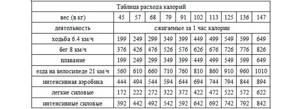
Some physical activity will help normalize weight with problematic blood pressure. Your doctor will tell you what sports activities may be useful. In this situation, it is recommended:
- Charger.
- Aerobics.
- Tennis.
- Walking.
- Gymnastics.
- Power training.
- Cycling.
For any exercise, it is important to observe the following conditions:
- Avoid intense workouts.
- The first sessions should not be long, 10-15 minutes is enough.
- Preference should be given to simple activities that allow the myocardium to gradually adapt to the load.
- Every week, increase the duration of exercise by 5 minutes, so that the time of further exercises is 30 or 60 minutes per day when training 5-6 days a week.
- You can achieve weight loss and stabilize blood pressure only with regular exercise (at least three days a week).
- All classes should end with stretching and eliminating tension in the muscles.
- After completing the exercises, be sure to measure your blood pressure for an hour and write down the results in a special notebook.
- If the tonometer shows deviations from the norm, notify your doctor.
Walking

The best option for beginners who want to get rid of obesity and problematic blood pressure is walking with an energetic step.
- You need to start with a 10-minute walk.
- Immediately after its completion, perform stretching, but without any bending. Duration – 5 minutes.
- After 3 weeks, you can introduce classes on an exercise bike or aerobics (course for beginners).
- If during exercise you experience unpleasant symptoms, such as weakness, headache or increased heart rate, you should reduce the intensity of the load.
Dumbbells
Regarding strength training (lifting dumbbells), it should be borne in mind that effective weight loss is achieved by the accumulation of muscle tissue, which can be obtained through regular strength exercises.
However, such physical exercises always involve working with dumbbells or on sports equipment. Under such stress, the heart experiences a high load, which inevitably leads to a jump in blood pressure.
To avoid this, hypertensive patients need to:
- Exercise with light dumbbells.
- During exercise, do not hold your breath, which is dangerous due to a surge in blood pressure.
- Perform exercises at a slow or moderate pace.
- During training, listen to how you feel.
- If you feel worse, stop exercising immediately and consult a doctor.
The following exercises with dumbbells are suitable for losing weight with hypertension:
- Bench press
- Squats.
- Push ups.
- Lunges.
- Raising hands.
Cleansing the body
When there is slagging and accumulation of toxic substances, it is difficult for the body to get rid of extra pounds. Proper implementation of health-improving cleansing helps to reduce body weight and normalize blood pressure due to the self-dissolution and removal of these harmful substances. If you do cleansing procedures for 3-7 days, the body’s cells begin to heal and recover.
It should be noted that complete fasting for 1-2 weeks helps to lose weight and stabilize blood pressure, but this drastic method is not suitable for all patients with problematic blood pressure, and in advanced stages of the disease it is extremely dangerous. Therefore, before you start cleansing the body, you should consult a cardiologist.
The following types of cleaning are popular at home:
| Cleansing method | Features of the event |
| Apples | They are natural antioxidants. Accelerate exchange processes. Eliminate toxins and heavy metal salts. |
| 15 minutes after waking up, you need to eat 2 green apples. After 2 hours - 1-2 more pieces. For lunch - oatmeal with two apples (cut into cubes). Before bed – 2-3 apples. The duration of the course is no more than 7-10 days. Weight loss – 5-10 kg. | |
| Soda | Soda solution allows you to cleanse all important systems and organs. Dissolve 0.5 tsp in 300 ml of water. soda Drink morning and evening on an empty stomach. Duration – no more than 10 days. |
| The downside is that there may be an imbalance in the acid balance, so this option is not suitable for hypertensive patients with gastrointestinal diseases. | |
| Water | Cleansing is carried out with clean water and herbal drinks. During cleaning, you should avoid drinking black tea, coffee, and alcoholic beverages. |
| For every 1 kg of body weight you need to take 30 ml of water. Drink lightly salted water or mineral water without gas. Take the liquid 45 minutes before meals or 2 hours after it. The duration of the method is 2-3 months. | |
| Flax seeds | Grind 1 kg flax seeds. Add 900 ml olive oil. Shake well and let sit for 7 days. Use 1 tsp. 3 times a day. The duration of the cleansing is 2 weeks. Repeat after 30 days. |
| Enema | Time for enema: from 6 to 8 am and from 21 to 23 pm. Pour 2 liters of heated filtered water into the rubber enema. Add 100 ml lemon juice. Hang the enema so that it is 50-80 cm above the floor. Take a knee-elbow position. Inject liquid. The enema holding time is 7-10 minutes. |
| Bran | For 250 ml of low-fat kefir you will need 100 g of bran. Use daily before bed. Course – 3 months. |
| Herbal infusion | For 1 liter of boiling water, take 50 grams of: mint, St. John's wort, chamomile, plantain. Leave for 50 minutes. Take 100 ml 4 times a day before meals. The treatment course is 6 months. |
The effectiveness of diets and the speed of weight loss
Salt intake should be reduced to a minimum.
By adhering to proper nutrition, it is quite possible for a patient with hypertension to lose up to 10 kg of excess weight in a month. In addition to effective weight loss, a diet designed specifically for hypertensive patients can significantly reduce blood pressure through the following processes:
Reducing the amount of salt in the patient’s diet stimulates the removal of excess fluid from the body, reducing blood pressure on the walls of blood vessels. The absence of fatty foods reduces cholesterol levels and improves the blood composition of hypertensive patients. Refusal of strong tea, coffee, and alcohol reduces the load on the patient’s cardiovascular system. Potassium and magnesium strengthen the blood vessels of a patient with hypertension, thin the blood, and reduce the risk of vascular spasms. Return to contents
How to eat with type 2 diabetes?
In type 2 diabetes, the sensitivity of body cells to the action of insulin decreases. Blood sugar levels rise above normal. A person with type 2 diabetes must adhere to a low-carbohydrate diet and give up sugar for life.
A menu for proper nutrition for type 2 diabetes and hypertension should contain, first of all, a sufficient amount of complete proteins . Even if the patient is overweight, the proportion of proteins in the diet cannot be reduced.
Recommended for hypertension, but limited for diabetes:
- porridge, pasta,
- potato;
- bananas;
- honey, jam, sugar.
It is only recommended to completely give up sugar and jam. Honey should also be consumed only occasionally and very little at a time. Bananas and pasta are on the verge of being blacklisted. It is recommended to soak potatoes to remove excess starch. As for porridges, there are no objections to buckwheat and oatmeal.
Recommended for diabetes, but limited for hypertension:
- mushrooms;
- onion garlic;
- radish, radish;
- cabbage.
Boiled cabbage is occasionally allowed.
For diabetics, it is better to use natural sweeteners, such as stevia. Sorbitol and xylitol harm blood vessels, saccharin has carcinogenic properties.
Cautions to this method of losing weight
A patient with hypertension who decides to lose weight through a diet needs to remember the following important rules:
For people suffering from high blood pressure, a safe weight loss process involves slowly losing body weight. The choice of diet should be taken very seriously, because many of those offered often lack vital substances (proteins, minerals, vitamins).Consumption dietary products are a way of life, not a temporary measure for hypertension. Return to contents
Disadvantages and dangers of the method
Losing weight too quickly is stressful for the body.
Despite the effectiveness of the diet for hypertension, from a medical point of view, too rapid a rate of weight loss will not bring benefit, and on the contrary, it can cause harm. Firstly, the stress of the body due to sudden weight loss and strict dietary restrictions will cause an exacerbation of the disease. Secondly, in addition to fat, the body will lose a significant amount of protein tissue and water at the same rate, which will provoke complications of hypertension or other diseases.
Return to contents
The need for a salt-free regime
The need to limit salt has already been mentioned. But during hypertensive crises and complications, it becomes necessary to completely abandon salt.
Crises can lead to severe damage to the heart and brain, and to the rapid development of pulmonary edema. At this time, the sodium-potassium balance is often disturbed in patients. There is a threat to life.
In severe cases of hypertension, a completely salt-free diet is prescribed.
Not everyone likes completely unsalted food. But vegetarians get used to it more easily: it’s easier to eat unsalted porridge or fresh cucumber than fish without salt.
Salt can be partially replaced with mild seasonings and herbs: dill, celery, parsley, cilantro, cumin, seaweed.

